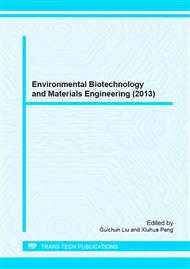[1]
H. Yoo, K. Ahn, H. Lee, et al, Nitrogen removal from synthetic wastewater by simultaneous nitrification and denitrification(SND) via nitrite in an intermittently reactor [J]. Water Res., 1999, 33 (1): 145-154.
DOI: 10.1016/s0043-1354(98)00159-6
Google Scholar
[2]
X. Wang, Y. Ma, Y. Peng, et al, Short-cut nitrification of domestic wastewater in a pilot-scale A/O nitrogen removal plant [J]. Bioprocess Biosyst Eng, 2007, 30: 91-97.
DOI: 10.1007/s00449-006-0104-x
Google Scholar
[3]
O. Turk, D.S. Mavinic, Maintaining nitrite build-up in a system acclimated to free ammonia [J]. Water Res., 1989 (23): 1383-1388.
DOI: 10.1016/0043-1354(89)90077-8
Google Scholar
[4]
G. Ruiz, D. Jeison, R. Chamy, Nitrification with high nitrite accumulation for the treatment of wastewater with high ammonia concentration [J]. Water Res., 2003 (37): 1371-1377.
DOI: 10.1016/s0043-1354(02)00475-x
Google Scholar
[5]
G. Ciudad, O. Rubilar, P. Munoz, et al, Partial nitrification of high ammonia concentration wastewater as a part of a shortcut biological nitrogen removal process [J]. Process Biochemistry, 2005 (40): 1715-1719.
DOI: 10.1016/j.procbio.2004.06.058
Google Scholar
[6]
G. Ruiz, D. Jeison, O. Rubilar, et al, Nitrification-denitrification via nitrite accumulation for nitrogen removal from wastewater [J]. Bioresource Technology, 2006 (97): 330-335.
DOI: 10.1016/j.biortech.2005.02.018
Google Scholar
[7]
P.A. Wilderer, R.L. Irvine, M.C. Goronszy, Sequencing batch reactor technology [M]. London:IWA Publicating, 2001:45.
DOI: 10.2166/9781780402246
Google Scholar
[8]
P.A. Wilderer, I. Roske, A. Ueberschar, L. Davids, Continuous flow and sequenced batch operation of biofilm reactors; a comparative study of shock loading response, biofouling, 6 (1993) 295-304.
DOI: 10.1080/08927019309386232
Google Scholar
[9]
E. Aronld, B. Bohm, P.A. Wilderer, Application of activated sludge and biofilm sequencing batch reactor technology to treat reject water sludge dewatering systems; a comparison, Water Sci, Technol, 41 (2000) 115-122.
DOI: 10.2166/wst.2000.0019
Google Scholar
[10]
D.B. Wang, X.M. Li, Q. Yang, W. Zheng, Z.Y. Liu, J.B. Cao, X. Yue, T.T. Shen, G.M. Zeng, J.H. Deng, The probable metabolic relation between phosphate uptake and energy storages formation under single-stage oxic condition. 100(2009) 4005-4011.
DOI: 10.1016/j.biortech.2009.03.020
Google Scholar
[11]
D. H Ding, Y.X. Jin, C.P. Feng, X.T. Liu, Start-up and optimization of sequencing batch biofilm reactor (SBBR) based on an intelligent controlling system. Proceedings of 13th World Lake Conference. 2009, pp.849-853.
Google Scholar
[12]
A.T. Katie, B. Natalie, C.R. Ralf, Simultaneous nitrification and denitrification using stored substrate (PHB) as the electron donor in an SBR, Biotechnol. Bioeng. 83(2003) 706-720.
DOI: 10.1002/bit.10708
Google Scholar
[13]
Y.X. Jin, D.H. Ding, C.P. Feng, S. Tong, Performance of sequencing batch biofilm reactors with different control systems in treating synthetic municipal wastewater, Bioresource Technology 104 (2012) 12-18.
DOI: 10.1016/j.biortech.2011.08.086
Google Scholar
[14]
State Environmental Protection Administration, Water and Wastewater Monitoring Analysis Method, fourth ed. China Environmental Science Press, Beijing, (2002).
Google Scholar


